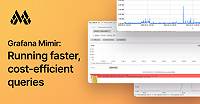Important: This documentation is about an older version. It's relevant only to the release noted, many of the features and functions have been updated or replaced. Please view the current version.
Configure custom active series trackers
You can use the custom tracker feature to count the number of active series on an ingester that match a particular label pattern.
The label pattern to match against is specified using the -ingester.active-series-custom-trackers CLI flag (or its respective YAML configuration option). Each custom tracker is defined as a key-value pair, where the key is the name of the tracker and the value is the label matcher. Both the key and the value are type <string>.
The following example configures a custom tracker to count the active series coming from dev and prod namespaces for each tenant.
active_series_custom_trackers:
dev: '{namespace=~"dev-.*"}'
prod: '{namespace=~"prod-.*"}'If you configure a custom tracker for an ingester, the ingester exposes a cortex_ingester_active_series_custom_tracker gauge metric on its /metrics endpoint.
Each custom tracker counts the active series matching its label pattern on a per-tenant basis, which means that each custom tracker generates as many as # of tenants series with metric name cortex_ingester_active_series_custom_tracker. To reduce the cardinality of this metric, only custom trackers that have matched at least one series are exposed on the metric, and they are removed if they become 0.
Series with metric name cortex_ingester_active_series_custom_tracker have two labels applied: name and user. The value of the name label is the name of the custom tracker specified in the configuration. The value of the user label is the tenant-id for which the series count applies.
To illustrate this, assume that two custom trackers are configured as in the preceding YAML snippet, and that your Grafana Mimir cluster has two tenants: tenant_1 and tenant_with_only_prod_metrics. Assume that tenant_with_only_prod_metrics has three series with labels that match the pattern {namespace=~"prod-.*"} and none that match the pattern {namespace=~"dev-.*"}. Also assume that tenant_1 has five series that match the pattern {namespace=~"dev-.*"} and 10 series that match the pattern {namespace=~"prod-.*"}.
In this example, the following output appears when the /metrics endpoint for the ingester component is scraped:
cortex_ingester_active_series_custom_tracker{name="dev", user="tenant_1"} 5
cortex_ingester_active_series_custom_tracker{name="prod", user="tenant_1"} 10
cortex_ingester_active_series_custom_tracker{name="prod", user="tenant_with_only_prod_metrics"} 3For specific tenants, you can override the default configuration as previously described. To do so, edit the runtime configuration.
You can override the active series custom trackers’ configuration for the tenant tenant_with_only_prod_metrics to track two services instead of the default matchers. See the following example:
overrides:
tenant_with_only_prod_metrics:
active_series_custom_trackers:
service1: '{service="service1"}'
service2: '{service="service2"}'After adding this override, and assuming that there is one matching series for service1 and two matching series for service2, the output at /metrics changes:
cortex_ingester_active_series_custom_tracker{name="dev", user="tenant_1"} 5
cortex_ingester_active_series_custom_tracker{name="prod", user="tenant_1"} 10
cortex_ingester_active_series_custom_tracker{name="service1", user="tenant_with_only_prod_metrics"} 1
cortex_ingester_active_series_custom_tracker{name="service2", user="tenant_with_only_prod_metrics"} 2To set up runtime overrides, refer to runtime configuration.
Note
Each ingester exposes the custom active series trackers.
To understand the count of active series matching a particular label pattern in your Grafana Mimir cluster at a global level, you must collect and sum this metric across all ingesters.
If you’re running Grafana Mimir with a
replication_factor> 1, you must also adjust for the fact that Mimir replicates the same series across your ingesters replication factor times.


